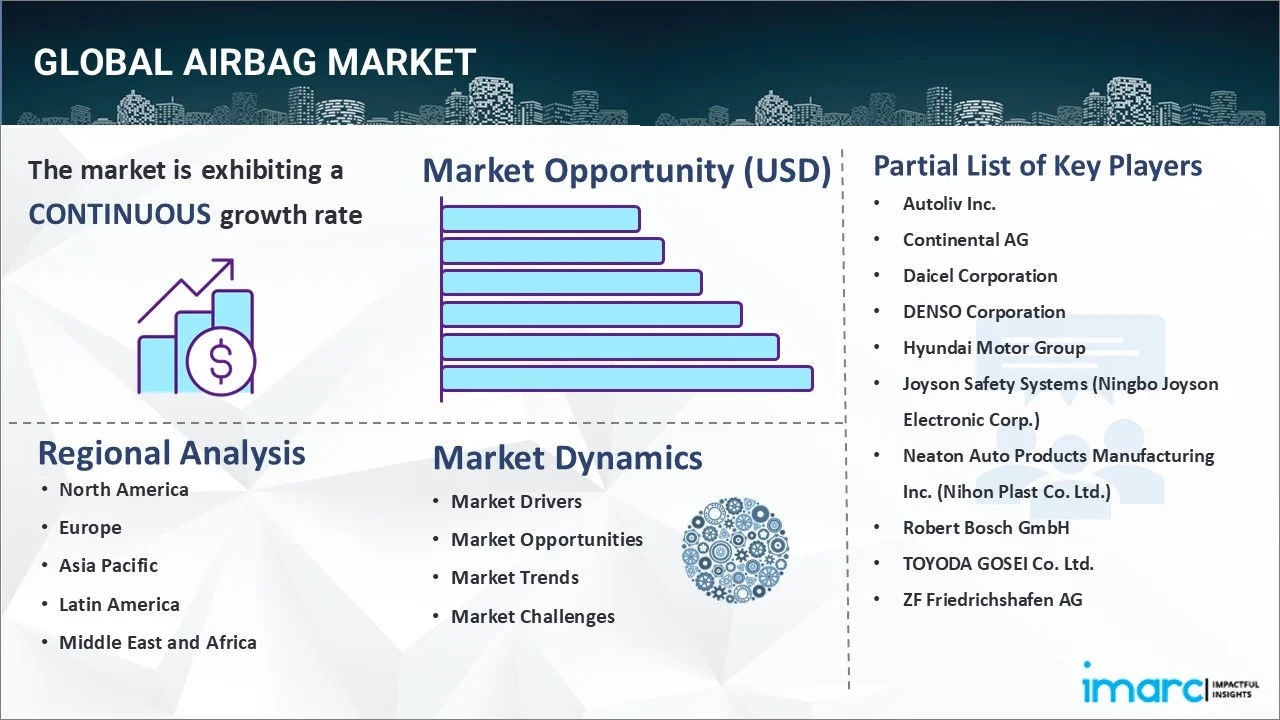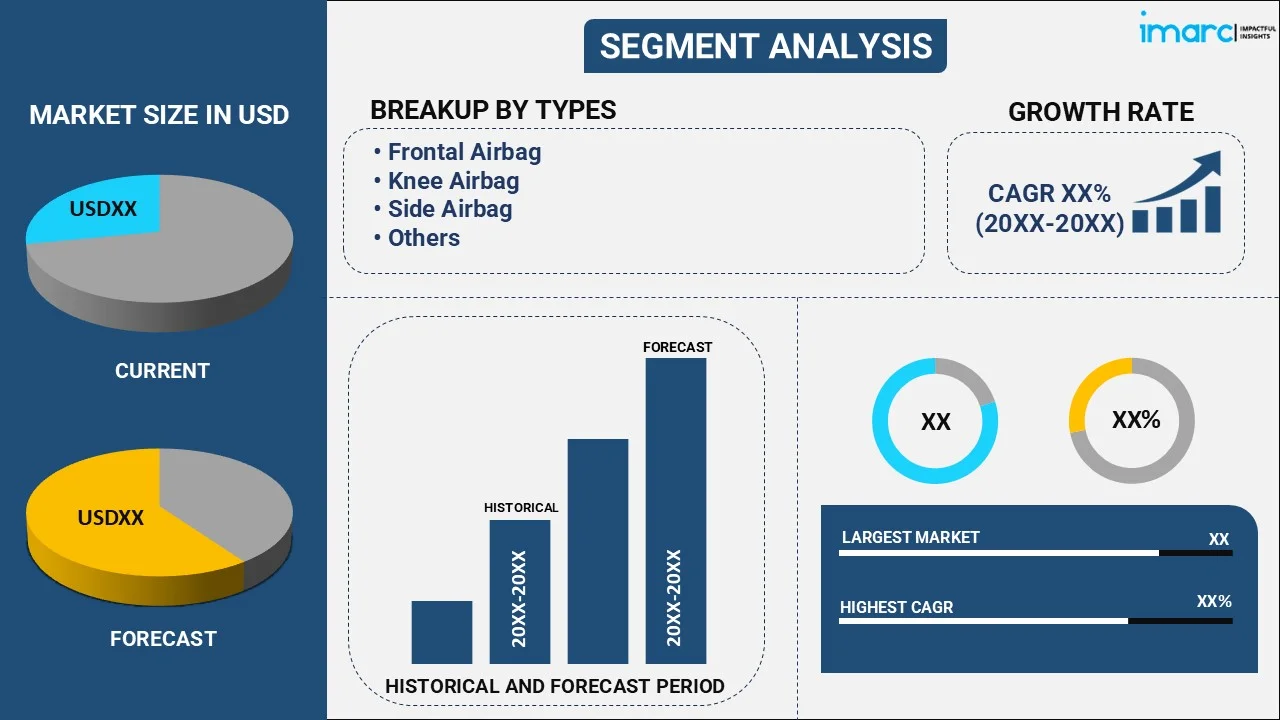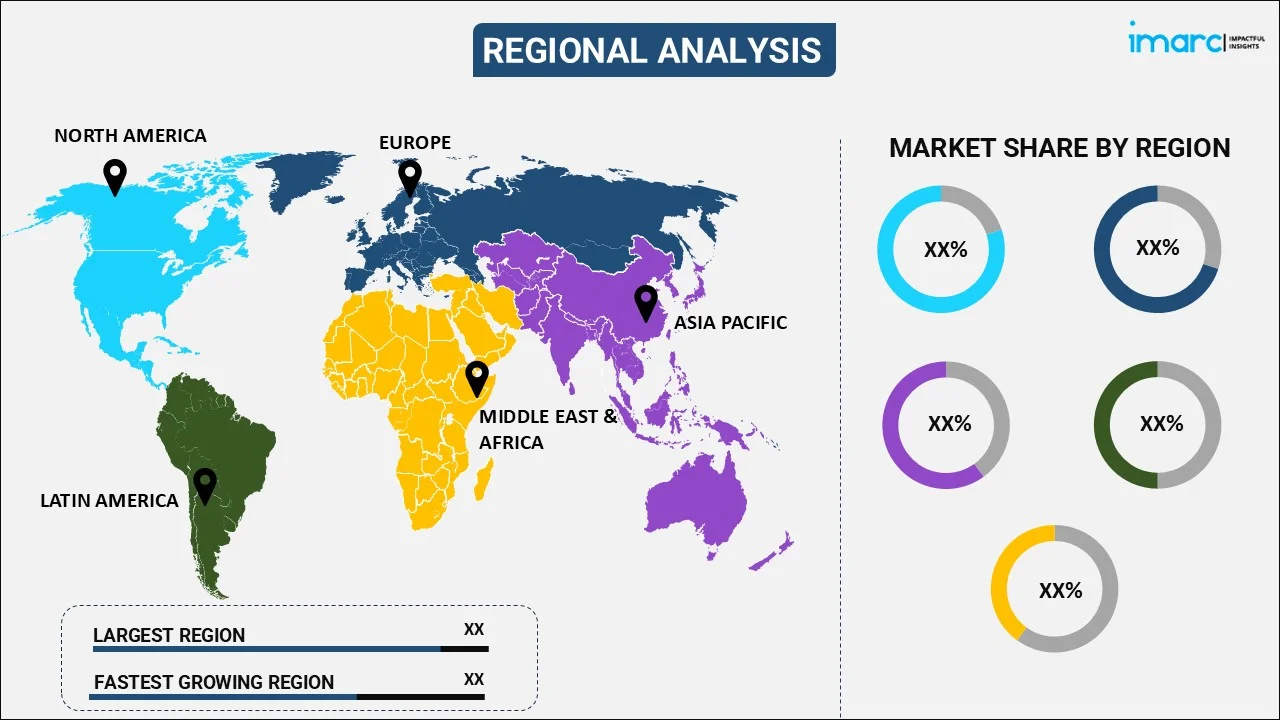
Airbag Market Report by Type (Frontal Airbag, Knee Airbag, Side Airbag, Curtain Airbag, and Others), Module (Inflator or Gas Generator, Air Bag, Crash Sensors), Vehicle Type (Passenger Vehicle, Commercial Vehicle), Sales Channel (Original Equipment Manufacturers, Aftermarkets), and Region 2025-2033
Airbag Market Size:
The global airbag market size reached USD 34.6 Billion in 2024. Looking forward, IMARC Group expects the market to reach USD 63.9 Billion by 2033, exhibiting a growth rate (CAGR) of 7% during 2025-2033. The market is experiencing robust growth, driven by the increasing vehicle production and sales, rapid technological advancements, rising incidence of road accidents, growing consumer awareness of vehicle safety, and imposition of stringent government regulation regarding passenger safety.
|
Report Attribute
|
Key Statistics
|
|---|---|
|
Base Year
|
2024
|
|
Forecast Years
|
2025-2033
|
|
Historical Years
|
2019-2024
|
|
Market Size in 2024
|
USD 34.6 Billion |
|
Market Forecast in 2033
|
USD 63.9 Billion |
| Market Growth Rate (2025-2033) | 7% |
With increasing concerns of consumers about vehicle safety, manufacturers are focusing on offering advanced safety solutions in their vehicles, including airbags. This has significantly boosted the airbag market size. Several countries are witnessing decreased road accident fatalities owing to the growing integration of vehicle safety technologies in vehicles. The decline in fatalities stresses the necessity of airbags in vehicles, thereby driving the market demand. The industry is witnessing increasing development of new solutions and technologies, including smart airbags, pedestrian airbags, and occupant sensor systems, to address the surge in demand for safer and innovative airbags.
Airbag Market Analysis:
- Major Market Drivers: Stringent safety rules and standards around the world have mandated the incorporation of airbags in automobiles, resulting in continuous demand. Furthermore, the rising vehicle production and sales, as well as technological developments in airbag systems such as smart airbags and enhanced deployment mechanisms, are contributing to the expansion of the market.
- Key Market Trends: There is a growing consumer awareness of automobile safety, which leads to increased demand for improved airbag systems. Furthermore, the integration of advanced driver assistance systems (ADAS) and the development of electric and self-driving vehicles that require specialized airbags are increasing the popularity of the market.
- Geographical Trends: Asia Pacific is currently leading the industry due to the region's thriving automotive industry, strong economic expansion, and rising vehicle ownership rates. Other regions are also seeing growth as disposable income rises and the number of vehicle accidents increases.
- Competitive Landscape: Some of the major market players in the airbag industry include Autoliv Inc., Continental AG, Daicel Corporation, DENSO Corporation, Hyundai Motor Group, Joyson Safety Systems (Ningbo Joyson Electronic Corp.), Neaton Auto Products Manufacturing Inc. (Nihon Plast Co. Ltd.), Robert Bosch GmbH, TOYODA GOSEI Co. Ltd., ZF Friedrichshafen AG, among many others.
- Challenges and Opportunities: The high costs involved with sophisticated airbag systems and their integration into vehicles present a considerable hurdle for manufacturers. However, opportunities exist in emerging nations, where rising disposable incomes and consumer safety awareness fuel the demand for airbag-equipped automobiles.

Airbag Market Trends:
Rising Incidence of Road Accidents
The growing number of road accidents across the globe is a crucial factor driving the airbag market growth. Despite advances in vehicle safety and traffic management, road accidents continue to be a serious concern, resulting in numerous fatalities and injuries. Every year, more than 6 million passenger car accidents occur in the United States. Road crashes are the main cause of death in the country, accounting for over 38,000 deaths. This alarming trend highlights the importance of effective safety measures to protect vehicle occupants during collisions. Airbags play an important role in this regard since they provide a cushioning effect that minimizes the force applied to occupants during a crash. As per the National Highway Traffic Safety Administration (NHTSA), frontal airbags have saved more than 50,000 lives over a 30-year period in the U.S., which has increased its demand.
Rapid Technological Advancements in Airbag Systems
Technological advancements play a pivotal role in increasing the airbag market share. The continuous innovation in airbag design, materials, and deployment mechanisms is significantly enhancing the effectiveness and reliability of airbag systems. For example, Hyundai Mobis developed an airbag that has a protruding area that maximizes pressure on the area about the time to prevent the passenger's head from turning. This effectively lowers the possibility of the driver receiving a head injury. In addition, the company has developed a total airbag solution designed for purpose-built vehicles (PBVs) in which they placed airbags in niche areas inside the vehicle to accommodate the varying interior design. Moreover, BMW has also introduced next-generation intelligent airbag systems in their BMW 5 and 7 series cars. The new system automatically assesses the severity of an impact and choose between two inflation rates for the front airbags.
Increasing Vehicle Production and Sales
The hike in vehicle production and sales is creating the demand for airbags. In the year 2022, 85.4 million motor vehicles were produced across the globe, which is a hike of 5.7% compared to 2021. The automotive sector is witnessing substantial growth owing to several factors, such as economic development, urbanization, and rising disposable incomes. These factors have been contributing to an increase in vehicle ownership, which is driving the need for safety features such as airbags. For instance, 16,480 thousand units of motor vehicles were produced in Europe during the year 2021, while on the same year, the household disposable income saw a hike of 2.6 %. This increased capacity in purchasing power is indirectly creating the demand for airbags.
Airbag Market Segmentation:
IMARC Group provides an analysis of the key trends in each segment of the market, along with forecasts at the global, regional, and country levels for 2025-2033. Our report has categorized the market based on type, module, vehicle type, and sales channel.
Breakup by Type:

- Frontal Airbag
- Knee Airbag
- Side Airbag
- Curtain Airbag
- Others
Frontal airbag accounts for the majority of the market share
The report has provided a detailed breakup and analysis of the market based on the type. This includes frontal airbag, knee airbag, side airbag, curtain airbag, and others. According to the report, frontal airbag represented the largest segment.
According to the airbag market analysis, frontal airbags dominated the market, driven by their critical role in providing essential protection during head-on collisions. They deploy from the steering wheel and dashboard, offering a crucial safety buffer to the driver and front passenger by reducing the impact force on the head and chest. The imposition of stringent regulations that mandate the inclusion of frontal airbags in all passenger vehicles, coupled with increasing consumer demand for enhanced safety features, is fueling the market growth.
Breakup by Module:
- Inflator or Gas Generator
- Air Bag
- Crash Sensors
Air bag holds the largest share of the industry
A detailed breakup and analysis of the market based on the module have also been provided in the report. This includes inflator or gas generator, air bag, crash sensors. According to the report, air bag accounted for the largest market share.
The airbag module accounted for the largest segment due to its fundamental role in automotive safety systems. They include the critical components necessary for airbag deployment, including the airbag cushion, inflator, and crash sensors. The widespread adoption of airbags across all vehicle categories, driven by stringent safety regulations and increasing consumer demand for enhanced safety features, is catalyzing the market growth. Additionally, rapid advancements in technology, such as the development of smart airbags and innovations in deployment mechanisms, are boosting the airbag market growth.
Breakup by Vehicle Type:
- Passenger Vehicle
- Commercial Vehicle
Passenger vehicle represents the leading market segment
The report has provided a detailed breakup and analysis of the market based on the vehicle type. This includes passenger vehicle and commercial vehicle. According to the report, passenger vehicle represented the largest segment.
As per the airbag market analysis, passenger vehicles accounted for the largest market share, driven by the high volume of passenger car production and sales across the globe. They include a wide range of vehicles, including sedans, hatchbacks, sports utility vehicles (SUVs), and luxury cars. The imposition of stringent government regulations mandating the inclusion of advanced safety features in new cars, alongside growing consumer awareness and demand for enhanced vehicle safety is boosting the market growth. Additionally, rapid advancements in airbag technology, such as the integration of side, curtain, and knee airbags, is contributing to the market growth.
Breakup by Sales Channel:
- Original Equipment Manufacturers
- Aftermarkets
Original equipment manufacturers exhibit a clear dominance in the market
A detailed breakup and analysis of the market based on the sales channel have also been provided in the report. This includes original equipment manufacturers and aftermarkets. According to the report, original equipment manufacturers accounted for the largest market share.
Original equipment manufacturers (OEMs) constituted the largest segment due to their integral role in incorporating airbag systems during the vehicle production process. They ensure that airbags are seamlessly integrated with the vehicle's design and safety architecture, complying with stringent regulatory standards and meeting consumer expectations for safety. Moreover, the continuous growth in vehicle production, as well as the increasing complexity and sophistication of airbag systems, which require precise engineering and compatibility with the vehicle's overall safety systems, is fueling the market growth.
Breakup by Region:

- North America
- United States
- Canada
- Asia-Pacific
- China
- Japan
- India
- South Korea
- Australia
- Indonesia
- Others
- Europe
- Germany
- France
- United Kingdom
- Italy
- Spain
- Russia
- Others
- Latin America
- Brazil
- Mexico
- Others
- Middle East and Africa
Asia Pacific leads the market, accounting for the largest airbag market share
The report has also provided a comprehensive analysis of all the major regional markets, which include North America (the United States and Canada); Asia Pacific (China, Japan, India, South Korea, Australia, Indonesia, and others); Europe (Germany, France, the United Kingdom, Italy, Spain, Russia, and others); Latin America (Brazil, Mexico, and others); and the Middle East and Africa. According to the report, Asia Pacific represents the largest regional market for airbag.
According to the airbag market analysis, Asia Pacific accounted for the largest market share, driven by the region's booming automotive industry and rapid economic growth. Moreover, the expanding middle class and increasing disposable incomes, leading to higher vehicle ownership rates, are propelling the market growth. Additionally, the imposition of stringent government regulations on vehicle safety, coupled with rising consumer awareness of the importance of automotive safety features, is bolstering the airbag market share. Apart from this, the presence of key automotive manufacturers and suppliers in the region, along with continuous investments in research and development (R&D), is enhancing the market growth.
Competitive Landscape:
- The market research report has also provided a comprehensive analysis of the competitive landscape in the market. Detailed profiles of all major companies have also been provided. Some of the major market players in the airbag industry include Autoliv Inc., Continental AG, Daicel Corporation, DENSO Corporation, Hyundai Motor Group, Joyson Safety Systems (Ningbo Joyson Electronic Corp.), Neaton Auto Products Manufacturing Inc. (Nihon Plast Co. Ltd.), Robert Bosch GmbH, TOYODA GOSEI Co. Ltd., ZF Friedrichshafen AG, etc.
(Please note that this is only a partial list of the key players, and the complete list is provided in the report.)
- The major players in the market are engaging in strategic initiatives to maintain and enhance their market positions. They are investing in research and development (R&D) to innovate and improve airbag technology by focusing on advanced features such as smart airbags and adaptive airbag systems. Moreover, key companies are engaging in collaborations and partnerships with automotive manufacturers to ensure the seamless integration of airbag systems into new vehicle models. Additionally, they are expanding their global footprint by establishing manufacturing facilities and R&D centers in emerging markets. They are also focusing on mergers and acquisitions to strengthen their product portfolios and gain a competitive edge.
Airbag Market News:
- In June 2024, Autoliv Inc. announced that it has developed yarns, fabrics, and cushions made from 100% recycled polyester for use in airbag production. The completed testing of the new material demonstrated that the airbag cushion provides equal safety functionality to a standard polyester airbag while reducing greenhouse gas (GHG) emissions by approximately 50% at the polymer level. Using this new recycled material is a crucial step toward Autoliv's commitment to reduce emissions across its product range and will contribute to Autoliv's ambition to achieve net-zero GHG emissions across the supply chain by 2040.
- In July 2024, ZF Friedrichshafen AG (ZF) announced that ZF LIFETEC has developed a new pre-crash dual stage side airbag (Dual Stage SAB) to increase protection during side collisions. ZF LIFETEC plans to bring this airbag to application maturity within the next few years. This airbag triggers its first stage around 200 milliseconds before the collision and pushes the occupants a few centimeters into the vehicle interior, away from the expected impact point.
Airbag Market Report Scope:
| Report Features | Details |
|---|---|
| Base Year of the Analysis | 2024 |
| Historical Period | 2019-2024 |
| Forecast Period | 2025-2033 |
| Units | Billion USD |
| Scope of the Report | Exploration of Historical Trends and Market Outlook, Industry Catalysts and Challenges, Segment-Wise Historical and Future Market Assessment:
|
| Types Covered | Frontal Airbag, Knee Airbag, Side Airbag, Curtain Airbag, Others |
| Modules Covered | Inflator or Gas Generator, Air Bag, Crash Sensors |
| Vehicle Types Covered | Passenger Vehicle, Commercial Vehicle |
| Sales Channels Covered | Original Equipment Manufacturers, Aftermarkets |
| Regions Covered | Asia Pacific, Europe, North America, Latin America, Middle East and Africa |
| Countries Covered | United States, Canada, Germany, France, United Kingdom, Italy, Spain, Russia, China, Japan, India, South Korea, Australia, Indonesia, Brazil, Mexico |
| Companies Covered | Autoliv Inc., Continental AG, Daicel Corporation, DENSO Corporation, Hyundai Motor Group, Joyson Safety Systems (Ningbo Joyson Electronic Corp.), Neaton Auto Products Manufacturing Inc. (Nihon Plast Co. Ltd.), Robert Bosch GmbH, TOYODA GOSEI Co. Ltd., ZF Friedrichshafen AG, etc. |
| Customization Scope | 10% Free Customization |
| Post-Sale Analyst Support | 10-12 Weeks |
| Delivery Format | PDF and Excel through Email (We can also provide the editable version of the report in PPT/Word format on special request) |
Key Questions Answered in This Report:
- How has the global airbag market performed so far, and how will it perform in the coming years?
- What are the drivers, restraints, and opportunities in the global airbag market?
- What is the impact of each driver, restraint, and opportunity on the global airbag market?
- What are the key regional markets?
- Which countries represent the most attractive airbag market?
- What is the breakup of the market based on the type?
- Which is the most attractive type in the airbag market?
- What is the breakup of the market based on the module?
- Which is the most attractive module in the airbag market?
- What is the breakup of the market based on the vehicle type?
- Which is the most attractive vehicle type in the airbag market?
- What is the breakup of the market based on the sales channel?
- Which is the most attractive sales channel in the airbag market?
- What is the competitive structure of the market?
- Who are the key players/companies in the global airbag market?
- Who is the largest manufacturer of airbags?
Key Benefits for Stakeholders:
- IMARC’s industry report offers a comprehensive quantitative analysis of various market segments, historical and current market trends, market forecasts, and dynamics of the airbag market from 2019-2033.
- The research report provides the latest information on the market drivers, challenges, and opportunities in the global airbag market.
- The study maps the leading, as well as the fastest-growing, regional markets. It further enables stakeholders to identify the key country-level markets within each region.
- Porter's five forces analysis assists stakeholders in assessing the impact of new entrants, competitive rivalry, supplier power, buyer power, and the threat of substitution. It helps stakeholders to analyze the level of competition within the airbag industry and its attractiveness.
- The competitive landscape allows stakeholders to understand their competitive environment and provides insight into the current positions of key players in the market.
Need more help?
- Speak to our experienced analysts for insights on the current market scenarios.
- Include additional segments and countries to customize the report as per your requirement.
- Gain an unparalleled competitive advantage in your domain by understanding how to utilize the report and positively impacting your operations and revenue.
- For further assistance, please connect with our analysts.
 Inquire Before Buying
Inquire Before Buying
 Speak to an Analyst
Speak to an Analyst
 Request Brochure
Request Brochure
 Request Customization
Request Customization




.webp)




.webp)












